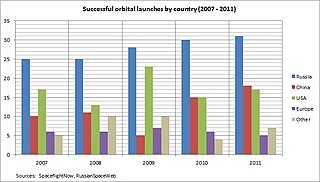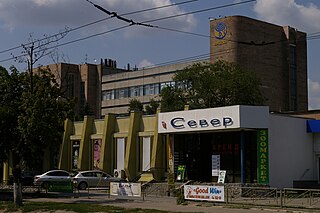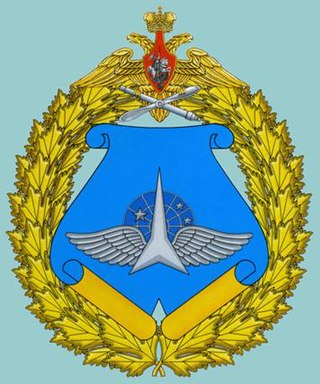Related Research Articles
The JSC A.S. Yakovlev Design Bureau is a Russian aircraft designer and manufacturer. Its head office is in Aeroport District, Northern Administrative Okrug, Moscow.

OKB is a transliteration of the Russian initials of "опытно-конструкторское бюро" – opytno konstruktorskoye byuro, meaning 'experiment and design bureau'. During the Soviet era, OKBs were closed institutions working on design and prototyping of advanced technology, usually for military applications. The corresponding English language term for such a bureau's activity is R&D or "research and development."

MKB Raduga is a Russian aerospace company, concerned with the production of various missile-systems and related technologies. It is headquartered in Dubna, Moscow Oblast. Formerly a division of the Mikoyan-Gurevich design bureau, it was spun off as a separate OKB in March 1957.

NPO Mashinostroyeniya is a rocket design bureau based in Reutov, Russia. During the Cold War it was responsible for several major weapons systems, including the UR-100N Intercontinental ballistic missile and the military Almaz space station program.

JSC Konstruktorskoe Buro Priborostroeniya (KBP) is one of the main enterprises in the field of Russian defense industry, based in Tula. It is engaged in designing high-precision weapon systems for the Army, the VMF and the VKS, as well as anti-air defense systems, high-rate-of-fire cannons and small arms, in addition to civilian products. Its full name goes as "Joint-Stock Company Instrument Design Bureau named after Academic A. G. Shipunov". Its shareholders include High Precision Systems, part of the State Corporation Rostec.

Moscow Institute of Thermal Technology is a Russian engineering and scientific research institute founded on May 13, 1946. The institute is located in the Otradnoye District in the north of Moscow.

Rocket and Space Centre "Progress" is a Russian joint-stock company under the jurisdiction of Roscosmos. It builds and operates the Soyuz family of rockets, the primary launch vehicle for the Russian space programme and derived from the R-7 missile.

JSC NPO Almaz named after A.A. Raspletin is a Soviet/Russian military R&D enterprise founded in 1947. It is the core of the Almaz-Antey holding. Headquarters – Moscow, Leningradsky av., 80.
KB Mashinostroyeniya or KBM for short is a state defence enterprise, scientific and design R&D centre specialised in missile systems located in Kolomna, Moscow region, Russia. Part of Rostec state corporation.

JSC Tactical Missiles Corporation (KTRV) (Russian: АО «Корпорация Тактическое Ракетное Вооружение», КТРВ) is a major Russian holding company for the manufacturers of military weapons (especially missiles), headquartered in Korolyov, Moscow Oblast.

EDB Fakel is a Russian electric propulsion system development company. It is located in Kaliningrad in Kaliningrad Oblast. It was founded in 1955 as a Propulsion laboratory of the Soviet Academy of Sciences; in 1962 it obtained status of Design Bureau, OKB.
JSC Vega Radio Engineering Corporation is a Russian company specializing in military radar and surveillance and C&C systems for ground-based, airborne and space systems like A-50, Almaz-1 and UAVs. Headquarters located in Moscow at 34, Kutuzovsky Prospekt.

Russia's space industry comprises more than 100 companies and employs 250,000 people. Most of the companies are descendants of Soviet design bureaux and state production companies. The industry entered a deep crisis following the dissolution of the Soviet Union, with its fullest effect occurring in the last years of the 1990s. Funding of the space program declined by 80% and the industry lost a large part of its work force before recovery began in the early 2000s. Many companies survived by creating joint-ventures with foreign firms and marketing their products abroad.
This is a glossary of acronyms and initials used for organisations in the Russian Federation and formerly the USSR. The Latin-alphabet names are phonetic representations of the Cyrillic originals, and variations are inevitable.

JSC "Khartron" (Hartron) is one of the leading design engineering bureaus in former Soviet states, which develops and produces spacecraft and missile control systems.

TsNIIMash is a Russian rocket and spacecraft scientific center, dealing with all phases of development from conceptual design to flight test. The Institute is the main analytical center of Roskosmos in the field of system-wide studies of the problems of the development of Russia's RKT with a wide range of tasks: from conceptual design and long-term prospects for the development of rocket and space technology to specific technological developments and their conversion in the interests of other industries. It was established in 1946.

30th Central Scientific Research Institute, Ministry of Defence was a scientific research organization operated by the Ministry of Defence of Russia which was dedicated to leading a wide range of studies in support of enhancing the Russian Air Force's capabilities and development of the aerospace warfighting methods, technologies and complexes.

JSC Design Bureau for Special Machine-Building is a Soviet-Russian space rockets industry enterprise. Currently, it is part of Almaz-Antey.

Anatoly Ivanovich Savin was a Soviet and Russian scientist. He was a specialist in the field of information and control automation systems. He was also a Doctor of Technical Sciences. Savin was the chairman of the Council on the problems of image processing and the scientific director of OJSC Almaz-Antey.
There are several surface-to-air missile design bureaus in Russia, including MKB Fakel, NPO Novator, and DNPP.
References
- ↑ "Kometa Central Science and Research Institute (TsNII)". www.globalsecurity.org.
- ↑ "Конструкторские бюро" (in Russian). «Военный паритет». Archived from the original on 2016-04-12.
{{cite web}}: CS1 maint: unfit URL (link) - 1 2 ""КОМЕТА", НПО, ЦНИИ (Центральный научно-исследовательский институт "Комета") г. Москва" (in Russian). «Семейные истории». Archived from the original on 2016-04-18.
- ↑ "Постановление о создании ЦНИИ "Комета"" (in Russian). Авиационный космический фонд. Archived from the original on 2016-03-04.
- ↑ "40-летие со дня образования предприятия" (in Russian). ОАО «Корпорация „Комета“». Archived from the original on 2016-04-12.
- ↑ Podvig, Pavel (2002). "History and the Current Status of the Russian Early-Warning System" (PDF). Science and Global Security. 10: 21–60. doi:10.1080/08929880290008395 (inactive 2024-09-19). Retrieved 16 February 2023.
{{cite journal}}: CS1 maint: DOI inactive as of September 2024 (link) - ↑ Докучаев, Анатолий (2001-05-18). "Гонка на космическом ТВД" (in Russian). Независимое военное обозрение. Archived from the original on 2016-04-12. Retrieved 2016-03-29.
- ↑ "ОАО "Корпорация космических систем специального назначения «Комета" (ОАО "Корпорация "Комета"")" (in Russian). Федеральное космическое агентство. Archived from the original on 2015-06-12.
- ↑ Zak, Anatoly. "US-K and US-KMO constellations". www.russianspaceweb.com. Retrieved 16 February 2023.
- ↑ Gordon, Yefim (2004). Soviet/Russian Aircraft Weapons Since World War Two. Hinckley, England: Midland Publishing. ISBN 1-85780-188-1.
- ↑ "Компании -> ФГУП "ЦНИИ "Комета"" (in Russian). Центральный металлический портал РФ. Archived from the original on 2016-04-10.